小学英语教案全英模板
小学英语的全英文教案范文

小学英语全英文教案范文一、Lesson IntroductionObjective: To introduce oneself and ask questions about others. Materials: Flashcards of animalsProcedure:1. Greet the students and ask them to sit in a circle.2. Show the flashcards of animals one one and ask the students to repeat the name of the animal in English.3. Introduce yourself saying, "Hello, my name is [Your Name]. I am a teacher. What's your name?" Ask the students to introduce themselves.4. Practice asking and answering questions like, "How old are you?" and "Where are you from?"二、Lesson 2: Greetings and IntroductionsObjective: To learn how to greet and introduce oneself.Materials: Flashcards of greetings and introductionsProcedure:1. Start the class with a warm-up activity, such as singing a greeting song.2. Show the flashcards of greetings and introductions, such as "Hello," "Good morning," "Good afternoon," and "Goode." Ask the students to repeat after you.3. Practice asking and answering questions like, "How are you?" and "I'm fine, thank you."4. Introduce a new student to the class and ask the students to greet and introduce themselves.三、Lesson 3: ColorsObjective: To learn how to name and describe colors in English. Materials: Flashcards of colorsProcedure:1. Start the class showing a colorful picture or object and ask the students to name the colors.2. Show the flashcards of colors one one and ask the students to repeat the color name in English.3. Practice describing colors using phrases like, "It's blue," "It's a red car," and "The sky is blue."4. Draw a colorful picture with the students and ask them to name the colors as you draw.四、Lesson 4: Numbers 1-10Objective: To learn how to count from 1 to 10 in English.Materials: Number flashcards, objects to countProcedure:1. Start the class counting with the students, "One, two, three, four, five." Continue counting up to 10.2. Show the number flashcards one one and ask the students to repeat the number in English.3. Give the students a set of objects, such as counters or toys, and ask them to count the objects using English numbers.4. Play a number game, such as "Simon Says" or "Number Memory," to reinforce the counting skills.五、Lesson 5: AlphabetObjective: To learn the English alphabet and the sounds of each letter. Materials: Alphabet flashcards, letter sounds chartProcedure:1. Start the class singing the "Alphabet Song" to familiarize the students with the English alphabet.2. Show the alphabet flashcards one one and ask the students to repeat the letter name in English.3. Expln the sounds of each letter in the alphabet using a letter sounds chart.4. Practice tracing the letters of the alphabet on a large whiteboard or chart paper, and ask the students to follow along.六、Lesson 6: Family MembersObjective: To learn how to name family members in English. Materials: Flashcards of family membersProcedure:1. Start the class asking the students about their family members in their native language.2. Introduce the concept of family members in English showing the flashcards of family members, such as "mother," "father," "brother," "sister," and "grandparent."3. Practice asking and answering questions about family members, like "Who is your mother?" and "I have a sister."4. Ask the students to bring a picture of their family and describe their family members in English.七、Lesson 7: Dly RoutinesObjective: To learn how to describe dly routines in English. Materials: Flashcards of dly routinesProcedure:1. Start the class discussing the dly routines of the students in their native language.2. Introduce the concept of dly routines in English showing the flashcards of dly routines, such as "wake up," "eat breakfast," "go to school," and "play."3. Practice asking and answering questions about dly routines, like "What do you do in the morning?" and "What do you do after school?"4. Ask the students to role-play their dly routines using English words and phrases.八、Lesson 8: ClothingObjective: To learn how to name and describe different types of clothingin English.Materials: Flashcards of clothingProcedure:1. Start the class discussing the types of clothing worn in different seasons.2. Introduce the concept of clothing in English showing the flashcards of different types of clothing, such as "shirt," "pants," "dress," "sunglasses," and "hat."3. Practice asking and answering questions about clothing, like "What are you wearing today?" and "I am wearing a skirt."4. Ask the students to bring a picture of themselves in different types of clothing and describe their clothing in English.九、Lesson 9: Food and DrinksObjective: To learn how to name and describe different foods and drinks in English.Materials: Flashcards of food and drinksProcedure:1. Start the class discussing the types of food and drinks liked the students.2. Introduce the concept of food and drinks in English showing the flashcards of different food and drink items, such as "apple," "banana," "orange," "milk," and "water."3. Practice asking and answering questions about food and drinks, like "What is your favorite fruit?" and "Can I have some water, please?"4. Ask the students to bring a picture of their favorite food or drink and describe it in English.十、Lesson 10: Review and AssessmentObjective: To review the topics covered in the previous lessons and assess the students' understanding.Materials: Review worksheets, flashcardsProcedure:1. Start the class reviewing the topics covered in the previous lessons, such as greetings, introductions, colors, numbers, family members, dly routines, clothing, food and drinks.2. Conduct a mini-assessment to evaluate the students' understanding asking them to answer questions related to the topics.3. Use flashcards to test the students' vocabulary retention asking them to name the items in English.4. Provide review worksheets for the students to plete, which include exercises like fill in the blanks, match the words with their pictures, and write short sentences using the learned vocabulary.5. Give feedback to the students on their performance and encourage them to continue practicing their English skills.重点和难点解析一、Lesson Introduction重点关注环节:Students' ability to ask and answer questions about themselves.难点解析:This lesson introduces the concept of asking and answering questions about oneself, which is a fundamental skill in language learning. The students may find it challenging to express their personal information accurately and confidently in English.二、Lesson 2: Greetings and Introductions重点关注环节:Students' ability to use greetings and introduce themselves.难点解析:Using proper greetings and introductions is crucial in dly munication. The students might struggle with remembering and applying the correct phrases in different situations.三、Lesson 3: Colors重点关注环节:Students' ability to name and describe colors in English. 难点解析:Naming and describing colors can be challenging for students, especially those whose native language does not use the same color palette as English.四、Lesson 4: Numbers 1-10重点关注环节:Students' ability to count from 1 to 10 in English.难点解析:Counting is a foundational math skill that can be difficult for students to master when learning a new language, as it involvesunderstanding the numerical system and sequencing.五、Lesson 5: Alphabet重点关注环节:Students' ability to recognize and pronounce each letter of the English alphabet.难点解析:The English alphabet may have letters that are not present in the students' native language, making it challenging for them to recognize and pronounce them correctly.六、Lesson 6: Family Members重点关注环节:Students' ability to name family members in English and ask about others'.难点解析:Understanding and using family vocabulary can be emotional and personal for students. They may find it difficult to remember the English words for extended family members or to ask about others' families.七、Lesson 7: Dly Routines重点关注环节:Students' ability to describe their dly routines in English. 难点解析:Describing routines involves sequencing and using past tense verbs, which can be plex for beginners to grasp.八、Lesson 8: Clothing重点关注环节:Students' ability to name and describe different types of clothing in English.难点解析:Clothing terms can be abstract and may not have directtranslations in students' native languages. Additionally, students may be self-conscious about discussing their attire.九、Lesson 9: Food and Drinks重点关注环节:Students' ability to name and describe different foods and drinks in English.难点解析:Food and drink vocabulary can be extensive, and students may have difficulty remembering the names of specific items or describing preferences.十、Lesson 10: Review and Assessment重点关注环节:Students' ability to review and apply the knowledge gned from the previous lessons.难点解析:Assessment can be stressful for students, especially if they feel unprepared. Ensuring that the review is prehensive and allows for individualized learning is crucial.这些教案环节涵盖了从自我介绍到日常生活中的各种主题,每个环节都有其特定的重点和难点。
小学英语全英说课稿模板
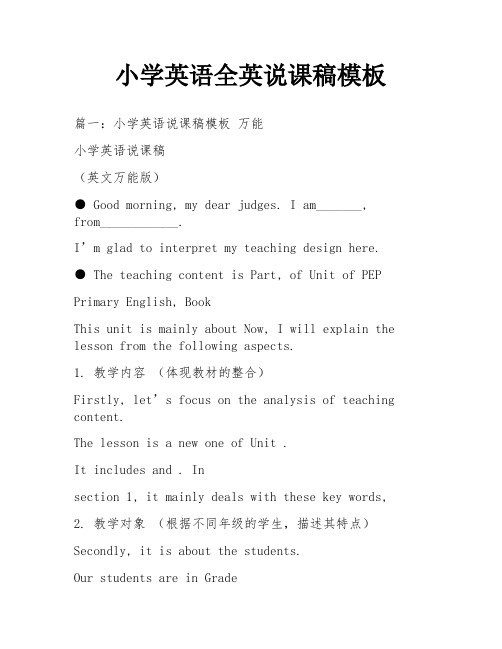
小学英语全英说课稿模板篇一:小学英语说课稿模板万能小学英语说课稿(英文万能版)● Good morning, my dear judges. I am_______, from____________.I’m glad to interpret my teaching design here.● The teaching content is Part, of Unit of PEP Primary English, BookThis unit is mainly about Now, I will explain the lesson from the following aspects.1. 教学内容(体现教材的整合)Firstly, let’s focus on the analysis of teaching content.The lesson is a new one of Unit .It includes and . Insection 1, it mainly deals with these key words, 2. 教学对象(根据不同年级的学生,描述其特点)Secondly, it is about the students.Our students are in GradeThey are active and curious, interested in new things.After learning English for years, they have some basic Englishbackground knowledge, so the teacher should attach importance to themunication with them, providing them the chances of using language.They have learnt English for years, and have already knownIt is not difficult for them to understand and use the language 3. 教学目标(根据具体内容定目标和要求)So, I set the following aims.By the end of the lesson, students will be able to read, recognize, and usethese words:And, these sentences:By the end of the lesson,Ss can understand the and get useful information from the throughattentive listening / reading.Ss are able to talk about Ss can use to give suggestions onSs’ abilities of listening and speaking will be developed.(Affect;Learning strategies;cultural awareness.)In this lesson, the emotional aim isto help students cultivate and foster their abilities of working ingroups.to foster Ss’ consciousness of good-cooperation and properpetition.to help Ss cultivate their abilities to analyze and solve problemsindependently.to foster Ss’ initiative and creativeness.to help Ss to recognize and identify the differences between Chinese and English cultures on to help Ss know some and prehend theto make sure that Ss can use Correctlyskillfully.to develop Ss’ interest in English.The difficult point is:The pronunciation of 教法学法Fourthly, it talks about teaching methods.andIn this lesson, I will mainly use “Task-based teaching method”,“Communicative language teaching method” and “TPR teaching method”,and so on.4. 教学过程① 具体steps 根据具体内容定;② 板书steps + purpose 说明;③ 如有可能,同时完成layout设计;Next, let’s focus on the teaching procedures.I will finish the lesson in steps.It will cost about mins.After greeting with the Ss, I will begin the lesson by singing the song together with the Ss.Purpose:The purpose of this is to form a better English learning surrounding forthe Ss, and, at the same time, it provides situations to review the learntknowledgefor the next step.It will cost about mins.With the help of the PPT, I set a situation of by to stimulate the Ss’ interest of the lesson.By playing the PPT, IAnd then, (板书layout)The purpose of this is to present the new words and sentences in thesituation, which relates to the Ss’ real life experiences, to help the Ssunderstand the language easily and naturally.After presenting each new word (by the guessing game), I will impart theknowledge of pronunciation rules in teaching the new words.It is called Phonics.It can facilitate the Ss’ abilities to pronounce the words, and help them toremember the spelling of the words.(机械上口;有意义操练;let’s do;课文对话表演;)It will cost mins, including篇二:小学英语说课稿(全英版)小学英语说课稿①Good afternoon , Ladies and Gentlemen !My name is Wu Dan . I e from Tanggangzi School .I am very glad to be standing here and talking about Lesson 10 ,which is from Fun with English Book 3 Unit 2 .My teaching report includes four parts . Part 1 To analyze the book1.There are 3 units in Book 3 . This is Lesson 10 . The central item is how to master another sentence to express “ What’s the time ? ” and how to buy something. Using “ What’s the time ? ” hungry , cakes, bread and so on . We’ll study and drill the sentences and the word ’s pronunciation .2. According to the teaching outline and bining the students ’ situation , I make the teaching aims of this lesson as follows .a .The first is the aim of knowledge .It’s to learn and master two sentences. What time is it? I am hungry and then using them to express thetime and go shopping fluently and freelyb. The second is the aim of abilitiesThe creative spirit is quite important to the students. So I will pay much attention to train it in my class. Otherwise. I will try to train the students listening, speaking, reading and writing abilities, Mainlyimprove their municative abilities and encourage them to speak more English.C. The third is the aim of emotionMake the students have successful feeling and achievement. And make them be in English study.3.Important pointsThe first is to master and use the two sentences. What time is it? I’m hungry. The second is to master the usage of the words hungry, cakes and bread.4.Difficult points.I t’s the pronunciation of the two words. hungry, cakes, and how to use them fluently and freely . Part 2 . Teaching and learning methodsMake the students take part in class . Ask and answer in pairs and groups . I’ll use municative method , discussing method and seeing and hearing method to teach this lesson .Part 3 . Teaching aids .In order to interest the students . I’ll use a clock , recorder , cards and some food as my teaching aids . Part 4 . Teaching procedure .Step 1 RevisionBefore my class , I’l l get the students to sing an English song to keep themselves relax . Then I’ll use a clock to act it . What’s the time ? What’s thetime ? It’s eight o’clock . I’ll show threenumbers . When the students answer It’s ten o’clock . I’ll say : It’s ten . Today we’ll learn Lesson Ten . Then I'll put the clock on the blackboard .Step 2 Presentation and drillFirst I’ll point to the clock and ask , what time isit ? Students answer It’s ten . Then I go on moving thehands and ask .What time is it ?Students answerquickly .Second I’ll drill the sentences What time is it ?It’s ----- .pairs in pairs or row by row .Third When the students answer It’s 12:00 o’clock . I’ll point to my stomach and say .Oh I’m hungry .and I’ll eat a cake . Then I’ll go on saying I’mhungry .and I’ll eat another cake . I’ll act it four or five times . Then I ask a student to act it . I’m hungry , too . I’ll say two cakes , please .and the sentences .I’m hungry . Two cakes ,please.Forth :Listen to the dialogue and answer my questions.1.What time is it?2.How many cakes?Step 3 ConsolidationI’ll train the creative spirit of the students.I’ll give them three please. To act the dialogue freely .First at the 219 Park,second fruit shop Third department store.Step4.HomeworkEncourage my student to the market to buy something with his friends or parents.②Good morning, everyone!Today, I’ll say something about Unit 9 Part A in Book 4 of Oxford English.Background on the reformation of curriculum, this book can connect the life and act, emphasize the interest and experience of the Ss, the pictures are active and vivid. Grade four is the initial stage of English learning, so it stresses on the emotion of the Ss, creates a well beginning for the Ss. This Unit has 7 parts, we’ll learn Part A mainly, it embodies the repeating characterize. Review the learned language points “Where’s…”and the new language points will be represented in the following units. So this unit forms connecting links with a special meaning in this book.The content of this period is to use“Where’s\are…” to determine the place. And according to the contents and the fact of the Ss, I establish the following three teaching aims of this period:The first one: students can listen, read, say andspell the following words: a glass, a fridge, an egg, bread and a table.The second one: students can listen, read, say andwrite the following daily expressions: What’s for breakfast?Have some juice then.The third one: students can listen, read, say andwrite the following sentence p atterns: Where’s\Where are the\my…It’s \They’re…There’s no …in \on \near…I think the most difficult point of this period is to make sure the students can use the patterns“Where’s\Where are…and There is no …in\on\near…” in their daily life correctly.And I will use some pictures, words and sentence cards, a tape recorder and the multi-media puter to help me achieve the aims.The task-based method, municated method, group cooperate method will be used in this period. To acplish the aims, I design the following steps:Step 1 Songs and the game arousers the emotion.In order to attract the Ss’ attention and constructan atmosphere of learning English, I let the studentssing some English songs and play the game “Simon says”. At the same time the game can review the prep, serve the knowledge as foil and consist the appearance of the knowledge.Step 2 Change class to life, happy to say.The substance of language is munication and the environment of munication is life. So when I present the sentence pattern “What’s for breakfast?” Ifirst show a clock to elicit the time for breakfast, teach the sentence. Then show my own photo of having breakfast, Ss ask and guess. In this way I can attract Ss’ attention, encourage Ss to ask Qs with the new knowledge.Most of the Ss have learnt the sentence pattern: Where’s…? so I design a task for Ss to help Helen find the food and drinks for breakfast, and teach the new language points: Where are…? They’re … Meanwhile stick the sentences on the Bb.After some practice by asking and answering, I present the next language points:There’s no …in\on\near…Have …then.And I will stick these sentence patterns on the Bb. Finally I’ll let the Ss do pair works to consolidate them. Step 3 Listen to the tape and Ss imitate to read and say.As the new reformation of curriculum, emphasized the traditional class attach importance to the mechanical teaching, neglect the experience and participation,for example, the five-step method. So in this lesson, after presentation, I ask Ss to listen to the tape with three Qs, read in different roles and in pairs, then try to recite the text.Step 4 Ss be the main body, T makes a guider.In class, Ss play as a host, and the T makes an influence on guiding, help Ss to act the learnt dialogue, it can stress the position of the Ss, and arouse their interest.Then I show a carton with no voice, ask Ss to make a dialogue in pairs.There are lots of ways to consolidate the new knowledge. Playing game is a good way. So according to the physiology of Ss, I hold a group petition during the game, ask Ss to finish the blanks. In this way can develop Ss’ good habits and achieve the aim of mastering the learned knowledge in situation. Step 5 Change class to life, learn by themselves.Is this the end of the class? I do n’t think so. If there is an end, I think it should be in the life. So I extend this class, encourage Ss to use the learned to municate with each other in their life.In a word, the whole period is based on tasks, which are designed from easy steps to steps that arechallenging. When the Ss are carting out the tasks, they can acquire information, knowledge, and havetheir ability and skills trained.That’s all. Thanks a lot for your attention.全英说课稿Good morning everyone. Standing here, I’m very happy and excited. It’s my greathonor to be here to present my lesson, and the chance is very precious for me. And I’ll try my best. Today I’ll talk about unit frommy contents consist of 8 parts Analysis of the teaching materialAnalysis of the studentsTeaching methodsTeaching aims and demandsTeaching aidsTeaching procedureBlackboard designAnd conclusionWell, firstly, I’ll talk about part 1 analysis of the teaching material. I have concluded the features of…….1 . there are a lot pictures. For this, the kids will be interested in the book. As we all know thatinterest is best teacher for the students.2. It lays stress on the munication. According to the problem of Chinese students learning English , the book design a lot of material to improve the students’ a bility of listening speaking, reading, and writing. So I think the book is very good.Then I’ll talk about next part analysis of the students. It is known to us that the kids are very active and like playing games very much, so during my class, I’ll design some interesting games to activate them to participate and learn something. They will also be interested in the class.Next I’ll talk about teaching methods. My teaching methods are task-based approach and situational approach. Using different methods can make the class active.Let’s move on to another part, teaching aims and demands. There are knowledge aims and ability aims.Knowledge aims are to enable the students to master the words and phrases:………. And the sentences:…Ability aims are To improve stud ents’listening and speaking ability by reading and practicing the dialogue.Next is the teaching aids. In this class, I’ll use pictures, PPT and tape recorder. These can arouse the students’ interest in English.Now I’ll talk about most important part tea ching procedure. It consists of 5 steps. Warning up, lead-in, contents key points and difficult points and homework. Step1 is warming up. Here I’ll use PPT to play a English song Bingo for the students and I’ll ask them try to follow it to sing together. By this, the students can beinterested in it and pay their attention to our class easily and improve their ability of speaking.Step2 is lead-in (导入根据所授内容设计,可通过展示与本课有关的话题或者图片等等引出本课话题)Step 3 is contents(本部分为主要授课内容及组织的课堂活动。
全英版小学英语教案【三篇】

【导语】⾼尚的理想是⼈⽣的指路明灯。
有了它,⽣活就有了⽅向;有了它,内⼼就感到充实。
迈开坚定的步伐,⾛向既定的⽬标吧!以下是为⼤家整理的《全英版⼩学英语教案【三篇】》供您查阅。
⼩学英语教案全英版⼀: Part A Let’s say, Let’s chant Part C Culture Teaching Aims : 1. Be able to listen, say, recognize the words: apple, ant, boy, bag, Coke, coffee. 2. Be able to listen, say, read and write these three letters: A a; B b; C c 3. Through the chant review the letters of ABC, train a sense of group identity. Focus Points & Difficult Points : Read the letters: Big letter C, small letter c; Write down them correctly and handsomely. Teaching Preparation: 1. Letter cards ,some word pictures, word cards: apple boy eraser ant crayon body head cake Coke coffee bag ball 2. A little blackboard with four-line format and a ball. Designing for the blackboard: panda beaver eagle kangaroo (pictures) China Canada America Australia (words) Teaching Steps: Step1. Warm –up 1. Sing a song. 2. Free talk T: Hello. I’m Wendy. I’m from Hangzhou. S1: Hello! I’m ... I’m from Hangzhou,too. T: Nice to meet you. S: Nice to meet you, too. T: Let’s play. Ok? S: Great! T: Watch out! (T throws the ball.) S: Oh, no. Make a similar dialogue with your partner. Step2.Presentation. 1. 1)T : Today, we will learn letters. Do you know letters? Just as A,B,C…… They are letters. What’s the meaning of letters? S: 字母。
小学英语全英万能教案模板

教学目标:1. 学生能够听懂并正确使用指定的英语词汇和句型。
2. 学生能够通过游戏和活动提高英语口语表达能力。
3. 学生能够理解并参与简单的英语对话,提高交际能力。
教学对象:小学一年级至六年级学生教学时长: 40分钟教学材料:- 教科书- 多媒体课件- 录音设备- 游戏道具- 工作纸教学步骤:一、Warm-up (5分钟)1. Greet students in English and ask them to introduce themselves.- Example: "Good morning, class! My name is Teacher. What's your name?"2. Play a simple icebreaker game, such as "Simon Says," to get students moving and engaged.二、Presentation (10分钟)1. Introduce new vocabulary and sentence structures using pictures or flashcards.- Example: Show a picture of a cat and say, "This is a cat. The cat says 'Meow.'"2. Use a PowerPoint or whiteboard to demonstrate the vocabulary and sentence structures.- Example: "Can you show me a book? Yes, I can show you a book. Can you give me a pen? Yes, I can give you a pen."三、Practice (15分钟)1. Pair students up and have them practice the new vocabulary and sentence structures in a dialogue format.- Example: "A: What's this? B: This is a ball. A: Can you throw the ball? B: Yes, I can throw the ball."2. Organize a role-play activity where students act out a short scenario using the new language.- Example: "A: I want to go to the park. B: OK, let's go to the park together."四、Game (10分钟)1. Play a fun and interactive game related to the new vocabulary and sentence structures.- Example: "Memory Game" where students find matching pictures or cards with the new vocabulary.五、Conclusion (5分钟)1. Review the new vocabulary and sentence structures with the class.- Example: "Today we learned about animals. Can you tell me what an animal says?"2. Have students create a short sentence using the new vocabulary.- Example: "I see a dog. The dog says 'Woof.'"六、Homework (5分钟)1. Assign a simple homework task to reinforce the lesson.- Example: "Draw a picture of your favorite animal and write a sentence about it."七、Assessment- Observe student participation and engagement during the activities.- Check homework submissions for understanding and application of the new language.备注:- 根据学生的年龄和英语水平,调整教学材料和活动难度。
2024年小学英语优秀教案全英
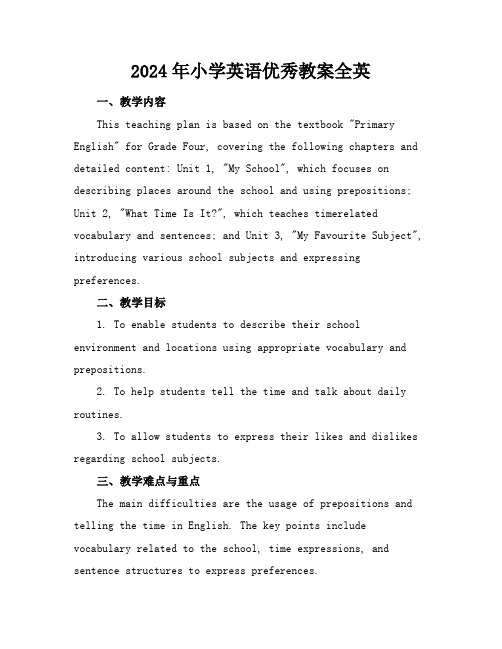
2024年小学英语优秀教案全英一、教学内容This teaching plan is based on the textbook "Primary English" for Grade Four, covering the following chapters and detailed content: Unit 1, "My School", which focuses on describing places around the school and using prepositions; Unit 2, "What Time Is It?", which teaches timerelated vocabulary and sentences; and Unit 3, "My Favourite Subject", introducing various school subjects and expressing preferences.二、教学目标1. To enable students to describe their school environment and locations using appropriate vocabulary and prepositions.2. To help students tell the time and talk about daily routines.3. To allow students to express their likes and dislikes regarding school subjects.三、教学难点与重点The main difficulties are the usage of prepositions and telling the time in English. The key points include vocabulary related to the school, time expressions, and sentence structures to express preferences.四、教具与学具准备Materials needed for the class include a textbook, a workbook, flashcards, a clock, a classroom poster, and student worksheets.五、教学过程1. Warmup: Engage students in a conversation about their school, asking questions like "What's your school like?" and "What's your favourite place in school?"2. Presentation: Introduce new vocabulary and sentence structures through flashcards and the textbook. Use reallife examples to make the learning process more engaging.3. Practice: Conduct group activities where students describe their school using prepositions and vocabulary learned. Provide worksheets for students to practice telling time.4. Production: Divide students into pairs and ask them to create a conversation about their daily routines, using timerelated vocabulary.5. Assessment: Evaluate students' understanding through a short quiz and oral participation.六、板书设计The blackboard will have three sections: one for vocabulary, one for sentence structures, and one for practiceexercises. Key points will be highlighted, and examples will be written on the board for students to refer to.七、作业设计2. Answer Key:a. 7:00 am The boy is waking up.b. 12:00 pm The students are eating lunch.c. 3:00 pm The girl is playing sports.d. 6:00 pm The family is having dinner.八、课后反思及拓展延伸1. Reflection: Assess the effectiveness of the teaching methods used and consider adjustments for future lessons.2. Extension: Encourage students to create their own daily routines using the vocabulary and sentence structures learned. They can share their routines with the class in the next lesson, fostering creativity and further practice.重点和难点解析1. 教学难点与重点的确定2. 教具与学具的准备3. 教学过程中的实践情景引入4. 作业设计一、教学难点与重点的确定利用实物、图片和情景模拟等多种教学手段,帮助学生形象地记忆词汇。
小学全英英语教案万能模板

一、教学目标1. 知识目标:学生能够熟练掌握本节课所学的词汇、语法知识。
2. 能力目标:学生能够运用所学知识进行简单的日常交流。
3. 情感目标:培养学生对英语学习的兴趣,提高学生的自信心。
二、教学内容1. 词汇:本节课所学词汇及短语。
2. 语法:本节课所学语法知识点。
3. 交际:本节课所涉及的日常交际情景。
三、教学重点与难点1. 教学重点:词汇、语法知识的掌握。
2. 教学难点:语法知识的运用和交际能力的提高。
四、教学过程1. 导入(1)歌曲导入:播放一首与主题相关的英文歌曲,激发学生学习兴趣。
(2)情景导入:展示与主题相关的图片或视频,引出本节课所学内容。
2. 词汇教学(1)新词汇展示:教师展示新词汇,并给出例句。
(2)词汇卡片游戏:学生通过卡片游戏,巩固所学词汇。
(3)词汇练习:教师设计练习题,让学生在练习中掌握词汇。
3. 语法教学(1)讲解语法知识点:教师详细讲解本节课所学的语法知识点。
(2)例句分析:通过分析例句,让学生理解语法知识。
(3)语法练习:教师设计练习题,让学生在练习中掌握语法。
4. 交际教学(1)情景模拟:教师创设与主题相关的情景,让学生进行角色扮演。
(2)小组讨论:学生分组讨论,运用所学知识进行交流。
(3)课堂展示:各小组展示讨论成果,教师进行点评。
5. 总结与反馈(1)总结:教师对本节课所学内容进行总结,强调重点和难点。
(2)反馈:学生回答问题,教师进行点评和纠正。
五、课后作业1. 完成课后练习题,巩固所学知识。
2. 预习下一节课的内容。
六、教学反思1. 教学过程中,关注学生的参与度和学习效果。
2. 根据学生的实际情况,调整教学方法和进度。
3. 鼓励学生积极参与课堂活动,提高学生的交际能力。
注:以上模板仅供参考,教师可根据实际情况进行调整。
小学英语全英教案【通用6篇】
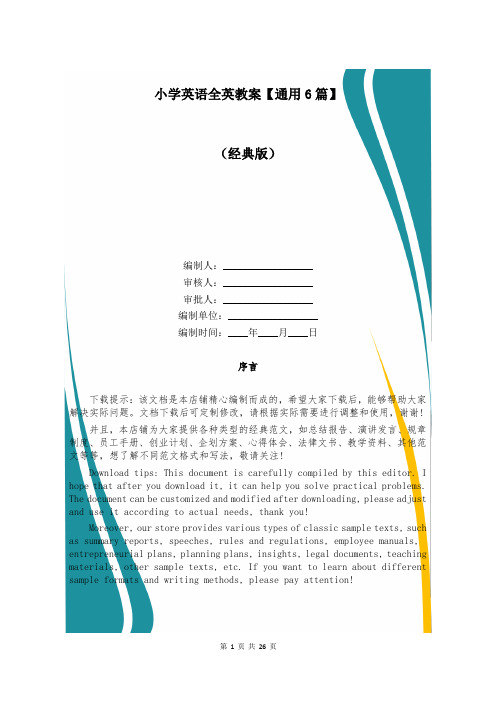
小学英语全英教案【通用6篇】(经典版)编制人:__________________审核人:__________________审批人:__________________编制单位:__________________编制时间:____年____月____日序言下载提示:该文档是本店铺精心编制而成的,希望大家下载后,能够帮助大家解决实际问题。
文档下载后可定制修改,请根据实际需要进行调整和使用,谢谢!并且,本店铺为大家提供各种类型的经典范文,如总结报告、演讲发言、规章制度、员工手册、创业计划、企划方案、心得体会、法律文书、教学资料、其他范文等等,想了解不同范文格式和写法,敬请关注!Download tips: This document is carefully compiled by this editor. I hope that after you download it, it can help you solve practical problems. The document can be customized and modified after downloading, please adjust and use it according to actual needs, thank you!Moreover, our store provides various types of classic sample texts, such as summary reports, speeches, rules and regulations, employee manuals, entrepreneurial plans, planning plans, insights, legal documents, teaching materials, other sample texts, etc. If you want to learn about different sample formats and writing methods, please pay attention!小学英语全英教案【通用6篇】小学英语全英教案篇一Section CCould you give us some advice on how to learn English well? 公安县自强初级中学杜亚兰Ⅰ.Material analysis 本课是九年级第三单元第三话题的第三课时。
小学英语全英教案(17篇)
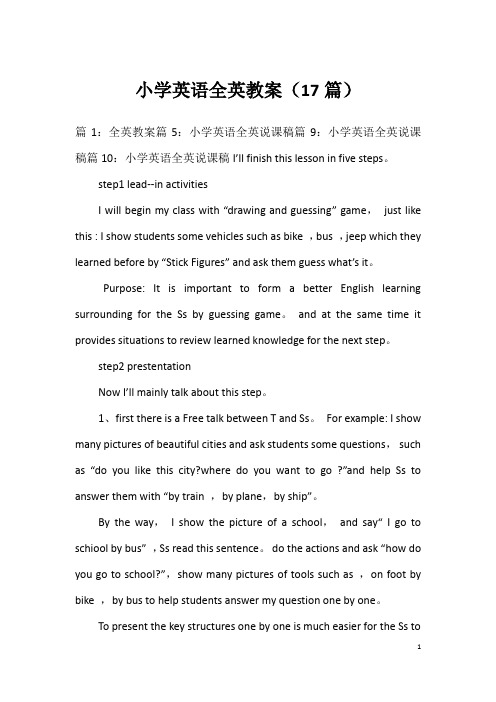
小学英语全英教案(17篇)篇1:全英教案篇5:小学英语全英说课稿篇9:小学英语全英说课稿篇10:小学英语全英说课稿I’ll finish this lesson in five steps。
step1 lead--in activitiesI will begin my class with “drawing and guessing” game,just like this : I show students some vehicles such as bike ,bus ,jeep which they learned before by “Stick Figures” and ask them guess what’s it。
Purpose: It is important to form a better English learning surrounding for the Ss by guessing game。
and at the same time it provides situations to review learned knowledge for the next step。
step2 prestentationNow I’ll mainly talk about this step。
1、first there is a Free talk between T and Ss。
For example: I show many pictures of beautiful cities and ask students some questions,such as “do you like this city?where do you want to go ?”and help Ss to answer them with “by train ,by plane,by ship”。
小学英语教学目标全英教案模板(共3篇)
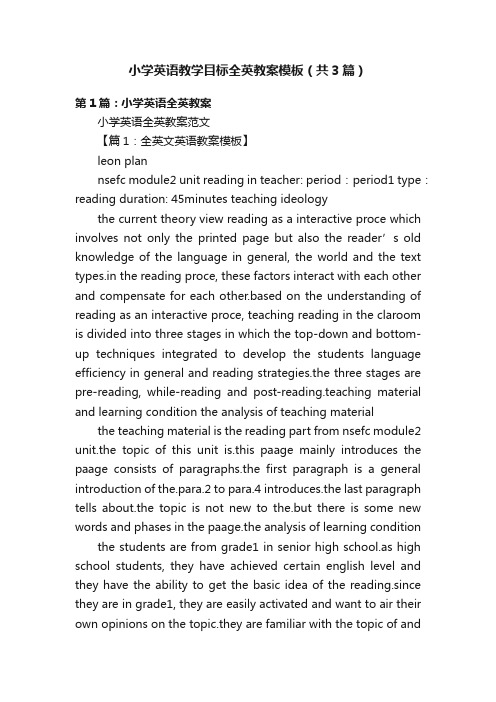
小学英语教学目标全英教案模板(共3篇)第1篇:小学英语全英教案小学英语全英教案范文【篇1:全英文英语教案模板】leon plannsefc module2 unit reading in teacher: period:period1 type:reading duration: 45minutes teaching ideologythe current theory view reading as a interactive proce which involves not only the printed page but also the reader’s old knowledge of the language in general, the world and the text types.in the reading proce, these factors interact with each other and compensate for each other.based on the understanding of reading as an interactive proce, teaching reading in the claroom is divided into three stages in which the top-down and bottom-up techniques integrated to develop the students language efficiency in general and reading strategies.the three stages are pre-reading, while-reading and post-reading.teaching material and learning condition the analysis of teaching material the teaching material is the reading part from nsefc module2 unit.the topic of this unit is.this paage mainly introduces the paage consists of paragraphs.the first paragraph is a general introduction of the.para.2 to para.4 introduces.the last paragraph tells about.the topic is not new to the.but there is some new words and phases in the paage.the analysis of learning condition the students are from grade1 in senior high school.as high school students, they have achieved certain english level and they have the ability to get the basic idea of the reading.since they are in grade1, they are easily activated and want to air their own opinions on the topic.they are familiar with the topic of andknow some.but they may not know before.moreover, their vocabulary is limited so they may have difficulties in understanding some sentences.learning objectives nguage skills ? at the beginning of the cla, can predict the content of the paage based on the title.? can scan the paage and find out the specific information such as the person related withcan summarize the paage with the help of the clues of the nguage knowledgecan master the key words and phrases of the paage as follows,.? can learn , especially 3.affectswill realize that and they will concern themselves with the iue of4.cultural awarenewill broaden their minds by knowing something about 5.learning strategieswill cultivate their ability individual learning and cooperative learning by doing someactivities independently and some in groups.? will communicate with each other in english while doing the group nguage difficultiesfocuses and anticipated language focusesthis is a reading period so the focus is to cultivate the students’ reading skills.the many activities are designed to help to train their reading skills, such as predicting, skimming, scanning and summarizing.it is also important for the to master the new words and phrases.anticipated difficultiesas the have a limited vocabulary, so they may have some difficulties in understanding the paage.so the teacher will help them learn the new words and phrases.may did not heard before, so the teacher will tell them some background knowledge aboutit.teaching methodthree-stage model: based on the understanding of reading as an interactive proce, teaching reading in the claroom is divided into three stages in which the top-down and bottom-up techniques integrated to develop the students language efficiency in general and reading strategies.the three stages are pre-reading, while-reading and post-reading.teaching aids multimedia devices and ppt documents: in order to help to fully understand the whole paage, i adopt multimedia devices and ppt documents to bring the real-life situation into the claroom.teaching procedures step1.lead-in(6min)activity1.greetings and free-talking(2min)t leads into the topic by asking some they know.tell the name of the they know freely.t: hello boys and girls.(say hello to the teacher.)t: when we say , what appears in your minds?(tell the things appear in their minds freely.)t: what are the ?(tell some names of.) activity2.picture-talking(4min)t shows some pictures about the in china and abroad.after seeing the pictures, are expected to tell the similarities of them.t: just now, you talk about some in china.now, let’s see some pictures of some.(t shows the pictures and see them carefully.) t: what do the have in common?for example, they are very precious.what are your opinions?(t gives them some hints and tell the characteristics of)[aims] in this step, t first leads in the topic by talking with the freely about the whichis familiar to them and then see some pictures and tell the characteristics.these two activities aim to arouse the ’ interests in the topic and activate their old knowledge of.then will bementally prepared for the reading comprehension.what’s more,when they are talking about the charateristics of, they will realize that theare rare and precious and they will concern themselves with the iue of.step2.pre-reading(3min)activity1.knowing something about(1min)t gives a brief introduction of the.will know the t: today, we are going to learn.it is.do you know what is?(t shows some pictures ofand get to know the.)activity2.predicting(2min)t asks to read the title of the paage and then ask them some questions.will predict the content of the paage with the help of the title.t: please look at the ti tle “”, what does “” mean?(if the can not give the answer, then t explain it.)t: in search means that people are looking for it.why are people looking for it? can you gue? what will the paage talk about?(predict the content, but t will not give the answer here.)[aims] in this step, the first know some information of the;the background information will make it easier for the to understand the paage.then t asks to make predictions about the paage.it aims to help develop the reading skills of predicting.step3.while-reading(22min)activity1.skimming(4min)skim the whole paage and find out and check their predictions.t: why are people still ? here is a multiple choice for you.activity2.scanning(3min)t presents several true or false statements and asks the to scan the paage and judge the right from the wrong.(keys: F,F,T,T,F)activity3 close-reading(15min)t designs various kinds of activities and do the activities to fully understand the paage.para.1t: please read para.1 carefully and then take some note aboutthe.para.2-4please read para.2-4 carefully and then find out the removal of the room.please read para.2-4 carefully and then find out the person related with the amber room and the things them down with it.para.5 please read para.5 carefully and then find out the the rebuilding of the amber room.【篇2:pep小学英语全英教案模板】the english teaching plan of pep book 4enhe primary school teacher:___________ the curriculum schedule cla:____________ cla:____________ the teaching schedule the students’ result tablethe english curriculum standard英语课程标准一级目标总体目标:对英语有好奇心,喜欢听他人说英语;能根据教师的简单指令做游戏、做动作、做事情(如涂颜色、连线);能做简单的角色扮演;能唱简单的英文歌曲,说简单的英语歌谣;能在图片的帮助下听懂和读懂简单的小故事;能交流简单的个人信息,表达简单的情感和感觉;能书写字母和单词;对英语学习中接触的外国文化习俗感兴趣。
小学英语全英教案模板-小学全英文教案模板
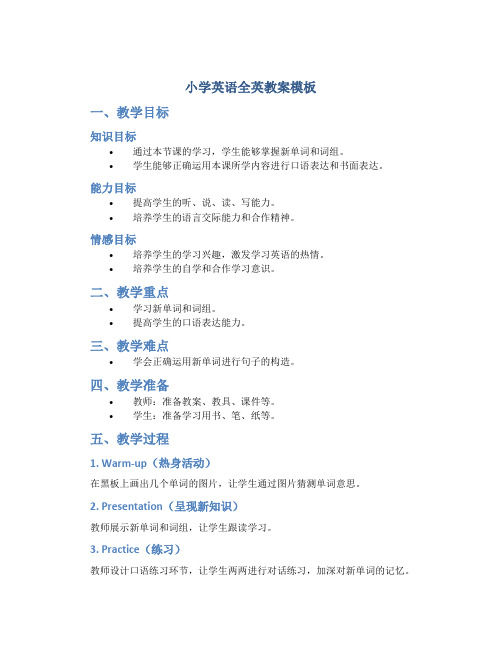
小学英语全英教案模板
一、教学目标
知识目标
•通过本节课的学习,学生能够掌握新单词和词组。
•学生能够正确运用本课所学内容进行口语表达和书面表达。
能力目标
•提高学生的听、说、读、写能力。
•培养学生的语言交际能力和合作精神。
情感目标
•培养学生的学习兴趣,激发学习英语的热情。
•培养学生的自学和合作学习意识。
二、教学重点
•学习新单词和词组。
•提高学生的口语表达能力。
三、教学难点
•学会正确运用新单词进行句子的构造。
四、教学准备
•教师:准备教案、教具、课件等。
•学生:准备学习用书、笔、纸等。
五、教学过程
1. Warm-up(热身活动)
在黑板上画出几个单词的图片,让学生通过图片猜测单词意思。
2. Presentation(呈现新知识)
教师展示新单词和词组,让学生跟读学习。
3. Practice(练习)
教师设计口语练习环节,让学生两两进行对话练习,加深对新单词的记忆。
4. Production(表达)
要求学生运用新学的单词和词组进行句子编写,展示个人观点。
5. Homework(作业布置)
布置相关作业,巩固所学内容。
六、教学反思
经过本节课的教学,学生对新单词的掌握情况如何?口语表达能力有所提高吗?如何改进教学方式提高学生的学习兴趣?
这份全英文教案模板力求通过多种学习方式和环节的设计,引导学生在轻松愉
悦的氛围中学习英语,培养其语言交际能力和合作精神,为日后的学习打下坚实的基础。
小学英语教学设计全英 小学英语教学设计一等奖汇总(5篇)

小学英语教学设计全英小学英语教学设计一等奖汇总(5篇)小学英语教学设计全英小学英语教学设计一等奖篇一一、英语unit 1《e with me》教学设计一、教学目标:1、认识目标: is this your dictionary? no,it's 'stony's does she do? she's a doctor.2、能力目标:listen and look3、情感目标:鼓励学生大胆开口说英语,用英语打招呼二、教学内容:listen and look三、教学重难点:重难点是句型的综合运用。
四、课前准备:录音机单词卡挂图五、教学过程:1、listen and sing.“what do you want to do?”2、ask and answer:--what's his name?(point to gogo)--his name's gogo.--can he fly?--yes,he can.--can he use magic?--yes,he can.3、让学生观看vcd,跟读,并把句子板书出来,学生认读。
--where are you going?--i'm going to an island.--we can't fly.--e withme./let's go.4、师生操练、生生操练句型。
5、呈现listen and look,要求学生把听到的句子说出来。
6、pair work and act.7、point and say.8、homework(1)把课文读给家长听。
(2)表演与同学的对话,用英语问候老师和同学。
六、板书设计: unit one e with me--where are you going?--i'm going to an island.--we can't fly.--e with me./let's go.七、教学反思:小部分学生比较难上口,需要反复读说。
小学英语全英说课稿(10篇)精选

小学英语全英说课稿(10篇)温馨提示:本文是笔者精心整理编制而成,有很强的的实用性和参考性,下载完成后可以直接编辑,并根据自己的需求进行修改套用。
小学英语全英说课稿第1篇:Part One Analysis of the Teaching Material(一) STATUS AND FUNCTION1。
This is an important lesson in Book One。
From this lesson, it starts asking the Ss to grasp contents of each Sample。
To attain four skills request of listening, speaking, reading and writing。
To start listing Word Bank and tell the Ss to remember the new words。
To start asking the Ss to write the English sentences well。
Therefore this lesson is in the important position of the teaching material。
2。
This lesson is the first one of Unit 2。
So if the Ss can learn it well, it will be helpful to make the Ss learn the rest of this unit。
3。
Such a topic is related to daily life, so it is helpful to raise learning interests of students and it will be also helpful to improve their spoken English。
小学英语全英文教案

小学英语全英文教案小学英语全英文教案「篇一」Theme: DiscussionFunction: Presenting different points of view。
Target Language: What do you suggest? What about ? Why don't you ? How about?I think so. I don't think so。
Vocabulary: suggest, quickly, excited, America, Chinese, kind, dragon, same, circlePronunciation: / / / / / / / /Poem: Do you agree?一、Warmer:1. Draw some pictures to help the Ss to learn the words: some chopsticks, a dragon, a kite, a radio, a CD2. Put the pictures on the board, then the teacher call out the names of the pictures and let the Ss point them。
二、Presentation:1. Look, listen and learn:A. Tell the Ss that you are going to play a dialogue. The Ss have to listen and tell you what things they are thinking of giving to the cousin。
B. They have to listen to the objects that are suggested in the text。
C. Tell the Ss to close their books. Play the dialogue and get the Ss to listen and note down their answers. Then ask them what objects they heard were mentioned。
小学英语教案万能模板全英

小学英语教案万能模板全英
第一部分:教学目标
•知识目标:掌握单词的拼读和基本意义。
•能力目标:能用简单的语句介绍自己。
•情感目标:培养学生积极参与英语学习的兴趣。
第二部分:教学准备
•教材准备:教科书、录音设备、课件。
•教具准备:黑板、彩色粉笔、图片卡片。
第三部分:教学过程
一、热身
1.复习上节课所学内容,引导学生进入英语学习状态。
2.通过唱歌、游戏等形式进行热身活动。
二、新课导入
1.准备图片卡片,引导学生猜测单词。
2.呈现新单词,并教授单词的拼读和意义。
三、学习活动
1.听录音,模仿发音,培养学生的听力和口语表达能力。
2.分组进行口语对话练习,让学生能够运用所学内容进行交流。
四、巩固练习
1.完成练习册上的练习题,巩固学习内容。
2.创设情景,让学生运用所学内容进行情景表演。
五、拓展延伸
1.引导学生自主学习,通过互动游戏等形式,加深对知识的理解。
2.带领学生欣赏英语歌曲、短片等,培养学生对英语的兴趣。
第四部分:课堂小结
•回顾本节课的重点内容,激励学生学习英语的积极性。
•提醒学生完成作业,准备好下节课的学习内容。
第五部分:作业布置
•完成课后练习册上指定的练习题,并背诵新学的单词。
第六部分:教学反思
•总结本节课的教学过程,反思教学中存在的问题并尝试改进。
通过以上教学模板,我们可以有效地指导小学生学习英语,激发他们对英语学习的兴趣,提高他们的语言表达能力。
希望本节课的设计能够对教师在小学英语教学中提供一定的帮助和启发。
小学英语全英教案模板-小学全英文教案模板
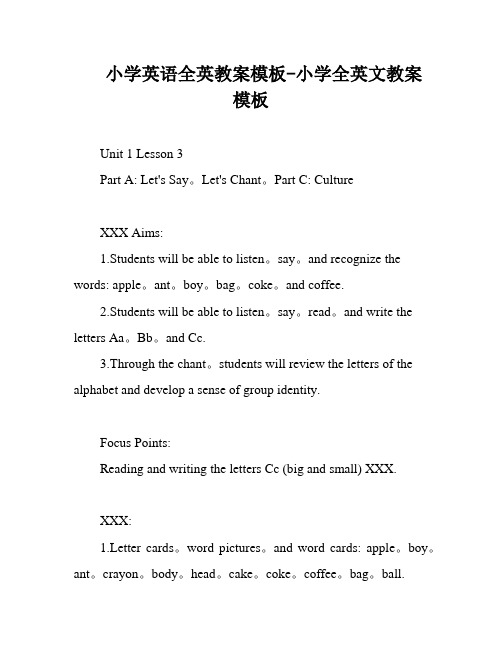
小学英语全英教案模板-小学全英文教案模板Unit 1 Lesson 3Part A: Let's Say。
Let's Chant。
Part C: CultureXXX Aims:1.Students will be able to listen。
say。
and recognize the words: apple。
ant。
boy。
bag。
coke。
and coffee.2.Students will be able to listen。
say。
read。
and write the letters Aa。
Bb。
and Cc.3.Through the chant。
students will review the letters of the alphabet and develop a sense of group identity.Focus Points:Reading and writing the letters Cc (big and small) XXX.XXX:1.Letter cards。
word pictures。
and word cards: apple。
boy。
ant。
crayon。
body。
head。
cake。
coke。
coffee。
bag。
ball.2.A small blackboard with four lines and a ball.Blackboard Design:Pictures: XXX。
beaver。
eagle。
kangarooWords: China。
Canada。
America。
AustraliaXXX:Step 1: Warm-up1.XXX.2.Free XXX.T: Hello。
I'm XXX.S1: Hello。
I'm from Hangzhou too.Note: The rest of the teaching materials and steps are missing。
小学英语教案全英文版【三篇】
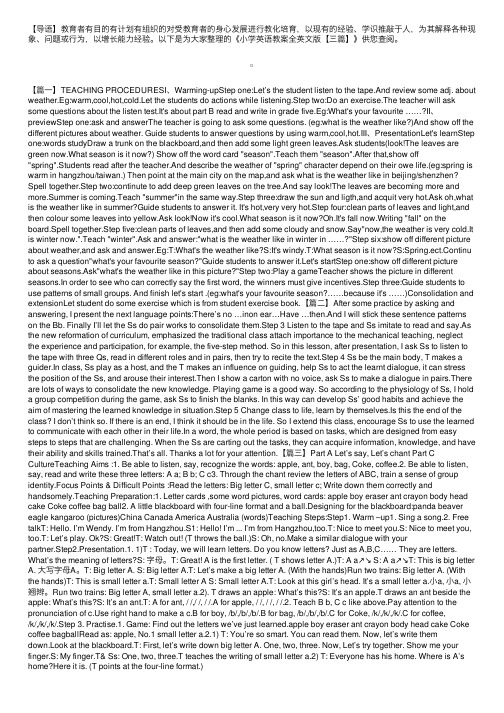
【导语】教育者有⽬的有计划有组织的对受教育者的⾝⼼发展进⾏教化培育,以现有的经验、学识推敲于⼈,为其解释各种现象、问题或⾏为,以增长能⼒经验。
以下是为⼤家整理的《⼩学英语教案全英⽂版【三篇】》供您查阅。
【篇⼀】TEACHING PROCEDURESI、Warming-upStep one:Let’s the student listen to the tape.And review some adj. about weather.Eg:warm,cool,hot,cold.Let the students do actions while listening.Step two:Do an exercise.The teacher will ask some questions about the listen test.It's about part B read and write in grade five.Eg:What's your favourite (II)previewStep one:ask and answerThe teacher is going to ask some questions. (eg:what is the weather like?)And show off the different pictures about weather. Guide students to answer questions by using warm,cool,hot.III、PresentationLet's learnStep one:words studyDraw a trunk on the blackboard,and then add some light green leaves.Ask students(look!The leaves are green now.What season is it now?) Show off the word card "season".Teach them "season".After that,show off "spring".Students read after the teacher.And describe the weather of "spring" character depend on their owe life.(eg:spring is warm in hangzhou/taiwan.) Then point at the main city on the map,and ask what is the weather like in beijing/shenzhen? Spell together.Step two:continute to add deep green leaves on the tree.And say look!The leaves are becoming more and more.Summer is coming.Teach "summer"in the same way.Step three:draw the sun and ligth,and acquit very hot.Ask oh,what is the weather like in summer?Guide students to answer it. It's hot,very very hot.Step four:clean parts of leaves and light,and then colour some leaves into yellow.Ask look!Now it's cool.What season is it now?Oh.It's fall now.Writing "fall" on the board.Spell together.Step five:clean parts of leaves,and then add some cloudy and snow.Say"now,the weather is very cold.It is winter now.".Teach "winter".Ask and answer:"what is the weather like in winter in ……?"Step six:show off different picture about weather,and ask and answer.Eg:T:What's the weather like?S:It's windy.T:What season is it now?S:Spring.ect.Continu to ask a question"what's your favourite season?"Guide students to answer it.Let's startStep one:show off different picture about seasons.Ask"what's the weather like in this picture?"Step two:Play a gameTeacher shows the picture in different seasons.In order to see who can correctly say the first word, the winners must give incentives.Step three:Guide students to use patterns of small groups. And finish let's start .(eg:what's your favourite season?……because it's ……)Consolidation and extensionLet student do some exercise which is from student exercise book.【篇⼆】After some practice by asking and answering, I present the next language points:There’s no …inon ear…Have …then.And I will stick these sentence patterns on the Bb. Finally I’ll let the Ss do pair works to consolidate them.Step 3 Listen to the tape and Ss imitate to read and say.As the new reformation of curriculum, emphasized the traditional class attach importance to the mechanical teaching, neglect the experience and participation, for example, the five-step method. So in this lesson, after presentation, I ask Ss to listen to the tape with three Qs, read in different roles and in pairs, then try to recite the text.Step 4 Ss be the main body, T makes a guider.In class, Ss play as a host, and the T makes an influence on guiding, help Ss to act the learnt dialogue, it can stress the position of the Ss, and arouse their interest.Then I show a carton with no voice, ask Ss to make a dialogue in pairs.There are lots of ways to consolidate the new knowledge. Playing game is a good way. So according to the physiology of Ss, I hold a group competition during the game, ask Ss to finish the blanks. In this way can develop Ss’ good habits and achieve the aim of mastering the learned knowledge in situation.Step 5 Change class to life, learn by themselves.Is this the end of the class? I don’t think so. If there is an end, I think it should be in the life. So I extend this class, encourage Ss to use the learned to communicate with each other in their life.In a word, the whole period is based on tasks, which are designed from easy steps to steps that are challenging. When the Ss are carting out the tasks, they can acquire information, knowledge, and have their ability and skills trained.That’s all. Thanks a lot for your attention.【篇三】Part A Let’s say, Let’s chant Part C CultureTeaching Aims :1. Be able to listen, say, recognize the words: apple, ant, boy, bag, Coke, coffee.2. Be able to listen, say, read and write these three letters: A a; B b; C c3. Through the chant review the letters of ABC, train a sense of group identity.Focus Points & Difficult Points :Read the letters: Big letter C, small letter c; Write down them correctly and handsomely.Teaching Preparation:1. Letter cards ,some word pictures, word cards: apple boy eraser ant crayon body head cake Coke coffee bag ball2. A little blackboard with four-line format and a ball.Designing for the blackboard:panda beaver eagle kangaroo (pictures)China Canada America Australia (words)Teaching Steps:Step1. Warm –up1. Sing a song.2. Free talkT: Hello. I’m Wendy. I’m from Hangzhou.S1: Hello! I’m ... I’m from Hangzhou,too.T: Nice to meet you.S: Nice to meet you, too.T: Let’s play. Ok?S: Great!T: Watch out! (T throws the ball.)S: Oh, no.Make a similar dialogue with yourpartner.Step2.Presentation.1. 1)T : Today, we will learn letters. Do you know letters? Just as A,B,C…… They are letters. What’s the meaning of letters?S: 字母。
PEP小学英语全英教案模板
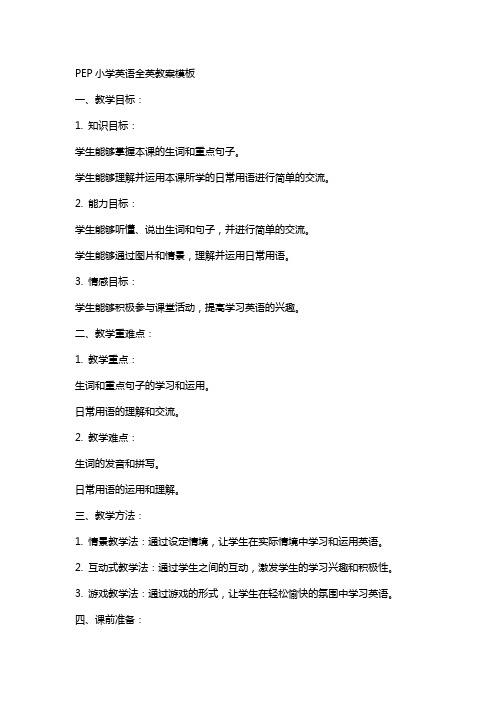
PEP小学英语全英教案模板一、教学目标:1. 知识目标:学生能够掌握本课的生词和重点句子。
学生能够理解并运用本课所学的日常用语进行简单的交流。
2. 能力目标:学生能够听懂、说出生词和句子,并进行简单的交流。
学生能够通过图片和情景,理解并运用日常用语。
3. 情感目标:学生能够积极参与课堂活动,提高学习英语的兴趣。
二、教学重难点:1. 教学重点:生词和重点句子的学习和运用。
日常用语的理解和交流。
2. 教学难点:生词的发音和拼写。
日常用语的运用和理解。
三、教学方法:1. 情景教学法:通过设定情境,让学生在实际情境中学习和运用英语。
2. 互动式教学法:通过学生之间的互动,激发学生的学习兴趣和积极性。
3. 游戏教学法:通过游戏的形式,让学生在轻松愉快的氛围中学习英语。
四、课前准备:1. 教师准备:准备本课的教学课件和教学材料。
熟悉本课的生词和句子,掌握教学重难点。
2. 学生准备:提前预习本课的生词和句子。
准备参与到课堂活动中。
五、教学过程:1. 课堂导入(5分钟):通过歌曲、游戏等方式,引导学生进入学习状态。
引导学生复习已学的生词和句子。
2. 生词教学(10分钟):通过图片和情景,教授本课的生词和句子。
让学生进行跟读和模仿,确保正确掌握发音。
3. 句子教学(10分钟):通过情景设定,让学生运用本课的句子进行交流。
引导学生进行角色扮演,巩固句子的运用。
4. 课堂活动(10分钟):组织学生进行小组活动,运用本课所学进行交流。
鼓励学生积极参与,提高口语表达能力。
5. 总结与作业布置(5分钟):对本课所学进行总结,强调重点和难点。
布置作业,要求学生巩固所学内容。
1. 课堂表现评价:观察学生在课堂上的参与程度、积极性以及口语表达能力。
2. 作业评价:检查学生作业的完成情况,巩固所学知识。
3. 单元测试评价:通过单元测试,评估学生对知识的掌握程度。
七、教学反思:在课后,教师应反思本节课的教学效果,包括学生的学习兴趣、教学方法的适用性以及学生的参与度等。
PEP小学英语全英教案模板
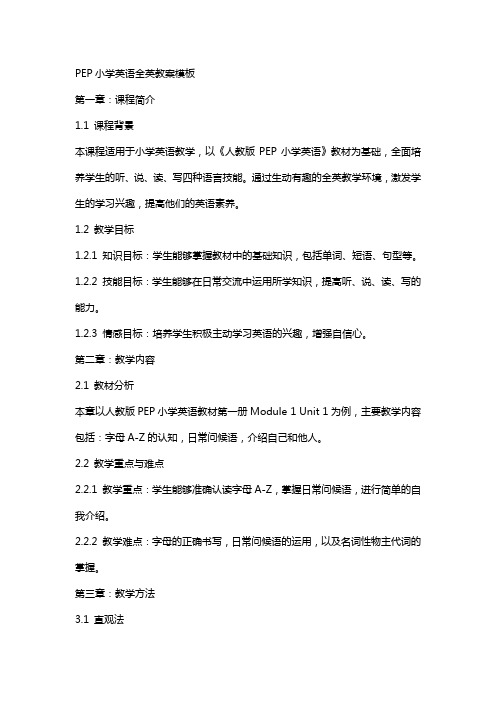
PEP小学英语全英教案模板第一章:课程简介1.1 课程背景本课程适用于小学英语教学,以《人教版PEP小学英语》教材为基础,全面培养学生的听、说、读、写四种语言技能。
通过生动有趣的全英教学环境,激发学生的学习兴趣,提高他们的英语素养。
1.2 教学目标1.2.1 知识目标:学生能够掌握教材中的基础知识,包括单词、短语、句型等。
1.2.2 技能目标:学生能够在日常交流中运用所学知识,提高听、说、读、写的能力。
1.2.3 情感目标:培养学生积极主动学习英语的兴趣,增强自信心。
第二章:教学内容2.1 教材分析本章以人教版PEP小学英语教材第一册Module 1 Unit 1为例,主要教学内容包括:字母A-Z的认知,日常问候语,介绍自己和他人。
2.2 教学重点与难点2.2.1 教学重点:学生能够准确认读字母A-Z,掌握日常问候语,进行简单的自我介绍。
2.2.2 教学难点:字母的正确书写,日常问候语的运用,以及名词性物主代词的掌握。
第三章:教学方法3.1 直观法通过图片、实物等直观教具,帮助学生形象地记忆字母和单词。
3.2 情景教学法创设日常生活中的情景,让学生在实际交流中学会运用所学知识。
3.3 游戏教学法设计有趣的英语游戏,让学生在游戏中轻松学习,提高学习兴趣。
第四章:教学步骤4.1 热身(5分钟)通过播放英语歌曲,引导学生跟着音乐唱,活跃课堂气氛。
4.2 导入(10分钟)教师展示图片,引导学生说出图片中的物品,进而引入字母的学习。
4.3 新课(20分钟)教师讲解字母的发音和书写,学生跟随教师一起书写。
教师教授日常问候语,学生进行角色扮演,模拟实际场景。
4.4 练习(10分钟)学生分组进行游戏,如“找朋友”游戏,巩固所学知识。
4.5 总结(5分钟)教师总结本节课所学内容,强调重点。
第五章:作业布置1. 抄写字母A-Z,每个字母两行。
2. 制作字母卡片,和家人一起复习字母。
3. 结合所学知识,与家人进行日常英语对话。
小学英语教案全英文版(优秀13篇)
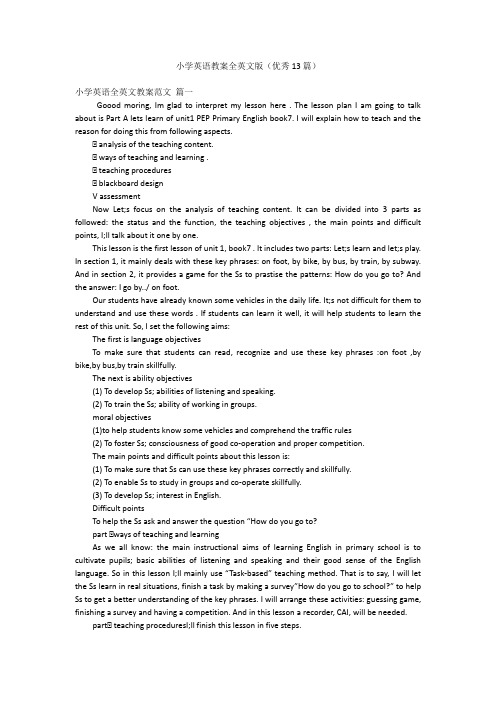
小学英语教案全英文版(优秀13篇)小学英语全英文教案范文篇一Goood moring, Im glad to interpret my lesson here . The lesson plan I am going to talk about is Part A lets learn of unit1 PEP Primary English book7. I will explain how to teach and the reason for doing this from following aspects.Ⅰ analysis of the teaching content.Ⅰ ways of teaching and learning .Ⅰ teaching proceduresⅠ blackboard designV assessmentNow Let;s focus on the analysis of teaching content. It can be divided into 3 parts as followed: the status and the function, the teaching objectives , the main points and difficult points, I;ll talk about it one by one.This lesson is the first lesson of unit 1, book7 . It includes two parts: Let;s learn and let;s play. In section 1, it mainly deals with these key phrases: on foot, by bike, by bus, by train, by subway. And in section 2, it provides a game for the Ss to prastise the patterns: How do you go to? And the answer: I go by../ on foot.Our students have already known some vehicles in the daily life. It;s not difficult for them to understand and use these words . If students can learn it well, it will help students to learn the rest of this unit. So, I set the following aims:The first is language objectivesTo make sure that students can read, recognize and use these key phrases :on foot ,by bike,by bus,by train skillfully.The next is ability objectives(1) To develop Ss; abilities of listening and speaking.(2) To train the Ss; ability of working in groups.moral objectives(1)to help students know some vehicles and comprehend the traffic rules(2) To foster Ss; consciousness of good co-operation and proper competition.The main points and difficult points about this lesson is:(1) To make sure that Ss can use these key phrases correctly and skillfully.(2) To enable Ss to study in groups and co-operate skillfully.(3) To develop Ss; interest in English.Difficult pointsTo help the Ss ask and answer the question “How do you go to?part Ⅰways of teaching and learningAs we all know: the main instructional aims of learning English in primary school is to cultivate pupils; basic abilities of listening and speaking and their good sense of the English language. So in this lesson I;ll mainly use “Task-based” teaching method. That is to say, I will let the Ss learn in real situations, finish a task by making a survey”How do you go to school?” to help Ss to get a better understanding of the key phrases. I will arrange these activities: guessing game, finishing a survey and having a competition. And in this lesson a recorder, CAI, will be needed.partⅠ teaching proceduresI;ll finish this lesson in five steps.step1 lead--in activitiesI will begin my class with drawing and guessing game, just like this : I show students some vehicles such as bike ,bus ,jeep which they learned before by Stick Figures and ask them guess what;s it.Purpose: It is important to form a better English learning surrounding for the Ss by guessing game. and at the same time it provides situations to review learned knowledge for the next step.step2 prestentationNow I;ll mainly talk about this step.1、first there is a Free talk between T and Ss. For example: I show many pictures of beautiful cities and ask students some questions, such as do you like this city?where do you want to go ?and help Ss to answer them with by train ,by plane,by ship.By the way, I show the picture of a school, and say“ I go to schiool by bus” ,Ss read this sentence. do the actions and ask how do you go to school?,show many pictures of tools such as ,on foot by bike ,by bus to help students answer my question one by one.To present the key structures one by one is much easier for the Ss to learn and grasp the meanings.2 With the help of the CAI I set a situation to help Ss understand the way of using these key phrases:A boy is coming, who is going to school. He says: I go to school byThen play the sounds of bus, bike ask students to listen carefully and tell “I go to school by according to the different sounds, by the way , I present another new phrases:by subwayPurpose:Make Ss use these new phrases with sentence structures, to help Ss use the language in a real situation.step3 practise3 I order to make every student read these new phrases correctly, I design a drill in this step,I show cards as soon as possible ,students should read the words quickly and spell them. Then I ask How do you go to school?students answer I go to ......also I will quicken the speed to ask .The purpose is to draw the whole studentsattention to the spelling of the words4 After this, I ask Ss to do Lets play in fours. They use places cards and vehicle cards, ask and answer:How do you go to ? I go to by”5, If Ss can ask and answer expertly, I will ask them to make a short dialogue.the purpose of this is to help students to learn those sentenses through a ture situation and make the dialogues in order to check if Ss can usse these key prases、sentences structures skillfullystep 4 consolidationlet students do a survey about how do you go to school?and the table like this :write down names and tools another Ss chooseTask-based teaching method is used here to develop Ss; ability of ; communication and also their ability of co-operation will be well trained.step 5 homeworkask students to collect other kinds of transport tools through the library ,computer.the purpose of this is to stimulate the interest of learning english and to wide the studentsknowledgestep6 blackboard designmy blackboard design like this :on the left Ishow the phrases:on foot,by bus.......on the right there are many sentences:how do you go to school?I go to ......step 7 assessmentdue to the studentsage ,I make every students work in class through many activities in order to stimulate the studentsinterest and provide they a wide thinking room. I make students learn this lesson very well through desiring scene statuesthats all,thank you for your listening !Unit 1 Lesson 篇二Part A Let;s say, Let;s chant Part C CultureTeaching Aims :1、Be able to listen, say, recognize the words: apple, ant, boy, bag, Coke, coffee.2、Be able to listen, say, read and write these three letters: A a; B b; C c3、Through the chant review the letters of ABC, train a sense of group identity.Focus Points amp; Difficult Points :Read the letters: Big letter C, small letter c; Write down them correctly and handsomely.Teaching Preparation:1、Letter cards ,some word pictures, word cards: apple boy eraser ant crayon body head cake Coke coffee bag ball2、A little blackboard with four-line format and a ball.Designing for the blackboard:panda beaver eagle kangaroo (pictures)China Canada America Australia (words)Teaching Steps:Step1. Warm ndash;up1、Sing a song.2、Free talkT: Hello. I;m Wendy. I;m from Hangzhou.S1: Hello! I;m 。
小学英语教案全英范文

小学英语教案全英范文【篇一:小学英语说课稿(全英版)】小学英语说课稿①good afternoon , ladies and gentlemen !my name is wu dan . i come from tanggangzi school .i am very glad to be standing here and talking about lesson 10 ,which is from fun with english book 3 unit 2 .my teaching report includes four parts . part 1 to analyze the book1.there are 3 units in book 3 . this is lesson 10 . the centralitem is how to master another sentence to express “ what’s the time ? ” and how to buy something. using “ what’s the time ? ” hungry , cakes, bread and so on . we’ll study and drill the sentences and the word ’s pronunciation .2. according to the teaching outline and combining the students ’ situation , i make the teaching aims of this lesson as follows .a .the first is the aim of knowledge .it’s to learn and master two sentences. what time is it? i am hungry and then using them to express the time and go shopping fluently and freelyb. the second is the aim of abilitiesthe creative spirit is quite important to the students. so i will pay much attention to train it in my class. otherwise. i will tryto train the students listening, speaking, reading and writing abilities, mainly improve their communicative abilities and encourage them to speak more english.c. the third is the aim of emotionmake the students have successful feeling and achievement. and make them be in english study. 3.important pointsthe first is to master and use the two sentences. what time is it? i’m hungry. the second is to master the usage of the words hungry, cakes and bread. 4.difficult points.it’s the pronunciation of the two words. hungry, cakes, andhow to use them fluently and freely . part 2 . teaching and learning methodsmake the students take part in class . ask and answer in pairs and groups . i’ll use communicative method , discussing method and seeing and hearing method to teach this lesson . part 3 . teaching aids .in order to interest the students . i’ll use a clock , recorder , cards and some food as my teaching aids . part 4 . teaching procedure .step 1 revisionbefore my class , i’ll get the students to sing an english song to keep themselves relax . then i’ll use a clock to act it . what’s the time ? what’s the time ? it’s eight o’clock . i’ll show three numbers . whe n the students answer it’s ten o’clock . i’ll say : it’s ten . today we’ll learn lesson ten . then ill put the clock on the blackboard .step 2 presentation and drillfirst i’ll point to the clock and ask , what time is it ? students answer it’s ten . th en i go on moving thehands and ask .what time is it ?students answer quickly . second i’ll drill the sentences what time is it ? it’s ----- .pairs in pairs or row by row .third when the students answer it’s 12:00 o’clock . i’ll point to my stomach and say .oh i’m hungry .and i’ll eat a cake . then i’ll go on saying i’m hungry .and i’ll eat another cake . i’ll act it four or five times . then i ask a student to act it . i’m hungry , too . i’ll say two cakes , please .and the sentences .i’m hungry . two cakes ,please.forth :listen to the dialogue and answer my questions.1.what time is it?2.how many cakes?step 3 consolidationi’ll train the creative spirit of the students.i’ll give them three please. to act the dialogue freely .first at the 219 park,second fruit shop third department store.step4.homeworkencourage my student to the market to buy something with his friends or parents.②good morning, everyone!today, i’ll say something about unit 9 part a in book 4 of oxford english.the content of this period is to use “where’s\are…” to determine the place. and according to the contents and the fact of the ss, i establish the following three teaching aims of this period:the first one: students can listen, read, say and spell the following words: a glass, a fridge, an egg, bread and a table.the second one: students can listen, read, say and write the following daily expressions: what’s for breakfast?have some juice then.the third one: students can listen, read, say and write the following sentence patterns: where’s\where are the\my…it’s \they’re…there’s no …in \on \near…i think the most difficult point of this period is to make sure the students can use the patterns “where’s\where are…and there is no …in\on\near…” in their daily life correctly.and i will use some pictures, words and sentence cards, a tape recorder and the multi-media computer to help me achieve the aims.the task-based method, communicated method, group cooperate method will be used in this period. to accomplish the aims, i design the following steps:step 1 songs and the game arousers the emotion.in order to attract the ss’ attention and construct an atmosphere of learning english, i let the students sing some english songs and play the game “simon says”. at the same time the game can review the prep, serve the knowledge as foil and consist the appearance of the knowledge.step 2 change class to life, happy to say.the substance of language is communication and the environment of communication is life. so when i present the sentence pattern “what’s for breakfast?” i first show a clock to elicit the time for breakfast, teach the sentence. then show my own photo of having breakfast, ss ask and guess. in this way i can attract ss’ attention, encourage ss to ask qs with the new knowledge.most of the ss have learnt the sentence pattern: where’s…? so i design a task for ss to help helen find the food and drinks for breakfast, and teach the new language points: where are…? they’re … meanwhile stick the sentences on the bb.after some practice by asking and answering, i present the next language points:there’s no …in\on\near…have …then.and i will stick these sentence patterns on the bb. finally i’ll let the ss do pair works to consolidate them. step 3 listen to the tape and ss imitate to read and say.as the new reformation of curriculum, emphasized the traditional class attach importance to the mechanical teaching, neglect the experience and participation, for example, the five-step method. so in this lesson, after presentation, i ask ss to listen to the tape with three qs, read in different roles and in pairs, then try to recite the text.step 4 ss be the main body, t makes a guider.in class, ss play as a host, and the t makes an influence on guiding, help ss to act the learnt dialogue, it can stress the position of the ss, and arouse their interest.then i show a carton with no voice, ask ss to make a dialogue in pairs.there are lots of ways to consolidate the new knowledge. playing game is a good way. so according to the physiology of ss, i hold a group competition during the game, ask ss to finish the blanks. in this way can develop ss’ good habits and achieve the aim of mastering the learned knowledge in situation. step 5 change class to life, learn by themselves.is this the end of the class? i don’t think so. if there is an end, i think it should be in the life. so i extend this class, encourage ss to use the learned to communicate with each other in their life.in a word, the whole period is based on tasks, which are designed from easy steps to steps that are challenging. when the ss are carting out the tasks, they can acquire information, knowledge, and have their ability and skills trained.that’s all. thanks a lot for your attention.全英说课稿good morning everyone. standing here, i’m very happy and excited. it’s my greathonor to be here to present my lesson, and the chance is very precious for me. and i’ll try my best. today i’ll talk about unitfrommy contents consist of 8 parts analysis of the teaching materialanalysis of the studentsteaching methodsteaching aims and demandsteaching aidsteaching procedureblackboard designand conclusionwell, firstly, i’l l talk about part 1 analysis of the teaching material. i have concluded the features of…….1 . there are a lot pictures. for this, the kids will be interested in the book. as we all know that interest is best teacher for the students.2. it lays stress on the communication. according to the problem of chinese students learning english , the book design a lot of material to improve the students’ ability of listening speaking, reading, and writing. so i think the book is very good. then i’ll talk about nex t part analysis of the students. it is known to us that the kids are very active and like playing games very much, so during my class, i’ll design some interesting games to activate them to participate and learn something. they will also be interested in the class.next i’ll talk about teaching methods. my teaching methods are task-based approach and situational approach. using different methods can make the class active.let’s move on to another part, teaching aims and demands. there are knowledge aims and ability aims.knowledge aims are to enable the students to master the words and phrases:………. and the sentences:…ability aims are to improve students’listening and speaking ability by reading and practicing the dialogue.next is the teaching aids. in this class, i’ll use pictures, ppt and tape recorder. these can arouse the students’ interest in english.now i’ll talk about most important part teaching procedure. it consists of 5 steps. warning up, lead-in, contents key points and difficult points and homework. step1 is warming up. here i’ll use ppt to play a english song bingo for the students and i’llask them try to follow it to sing together. by this, the students can beinterested in it and pay their attention to our class easily and improve their ability of speaking.step2 is lead-in (导入根据所授内容设计,可通过展示与本课有关的话题或者图片等等引出本课话题)step 3 is contents(本部分为主要授课内容及组织的课堂活动。
- 1、下载文档前请自行甄别文档内容的完整性,平台不提供额外的编辑、内容补充、找答案等附加服务。
- 2、"仅部分预览"的文档,不可在线预览部分如存在完整性等问题,可反馈申请退款(可完整预览的文档不适用该条件!)。
- 3、如文档侵犯您的权益,请联系客服反馈,我们会尽快为您处理(人工客服工作时间:9:00-18:30)。
小学英语教案全英模板【篇一:小学英语教案模板汇编(全册精选)】小学英语教案模板汇编(全册精选)【对于英语学科专业在事业单位教师、普岗教师、昆明教师、特岗教师面试说课或试或教师资格试讲中,到底是使用全英文的,还是可以使用汉语的,是所有考试面试的学生所纠结的一个问题,育萃面试为您提供了不同的案例。
其实不在乎你使用什么形式的说课稿或教案,关键是你是否运用的熟练。
在面试考试中,注意】《unit2 colours》教案一、教学目标能正确把握表示颜色的单词。
二、教学重点、难点能正确把握表示颜色的单词。
三、教学预备颜色纸或各种实物、单词卡片四、教学过程step 1 revision1.教师出第一课时的三个句型认读。
2.t: what’s this?s: it’s a book.t: what are these?ss: books.t: how many books?s: ??t: is it blue?s: yes.t: is it red?s: no.继续换几种物品提问。
3.出示第二课时的句型订读。
step 2 presentation1.教师拿出红、绿两种颜色纸: what colour is it?复习巩固red/ blue,并且认读。
2.教师拿出黄色纸:is it red? is it blue?教学yellow。
教师拿出一片叶子教学green教师拿出一个自制的红绿灯教学一首小诗:red, red stop;yellow yellow wait;green green go go go!3. t show an orange: what’s this ? it’s an orange. what colour is it? it’s orange.t: orange is orange.4.show a peach:what colour is it? it’s pink.教学粉红色。
5. show a chocolate: what colour is it? it’s brown.教学棕色。
6.show a grape: what colour is it? it’s purple.教学紫色。
7.ss read togetherstep 3 consolidation1.listen to the tape, point and read.2.教师拿着各种颜色纸,让学生说英语。
3.play a game: 规则:将各种颜色纸放入一个口袋内,让他们猜一猜摸到的东西是什么颜色的,猜对的小朋友奖励。
4.read together5.让小朋友在教室里找一些颜色。
step 4 homeworkread the new words.《we love animals》教案一、教学目标1.知识目标(1)能听、说、读、写本单元的动物类单词。
(2)进一步巩固句型:do you like...?yes,i do./no,i dont.以及i like...和i dont like...2.能力目标能够用几句连贯的英文向别人介绍自己的动物朋友以及它的特征。
3.情感目标使学生认识到人与动物之间的亲密友好的关系,从而树立应该保护自然、爱护动物的意识。
二、教学重点能够听、说、读、写本课的动物类单词。
三、教学难点较熟练地在情景中运用几句连贯英文向别人介绍自己的动物朋友。
四、教学准备多媒体课件、动物实物、若干动物名片。
五、学情分析学生学习剑桥英语已有一年半之久,他们学习英语的兴趣浓厚,已具备交流简单个人信息的能力。
活泼爱玩,好表现自己是他们的天性。
we love animals这一单元的主题是他们既熟悉又喜爱的动物,该课中的大部分动物单词学生已经学过,句型学生已熟练掌握,所以说学习这一课对于他们来说是件轻松愉快的事情。
六、教学过程1.leading int:just now,we watched the lion king,do you like animals?what can you see?which animals do you like?do you like panda?2.pre-task preparation(1)boys and girls,we are in the forest now,lets do some exercises.listen and act.hands up.hands down.act like a dog/cat/monkey.fly like a bird.swim like a fish.jump like a rabbit.run like a horse.walk like an elephant.(2)cai shows pictures of four animals tails.t:look and guess.what animals are they?s:its a dog/an elephant/a horse/a monkey.(3)cai shows eight photos of animals.t:look and say.what do you like?s:i like sheep...(4)lets chant.ss say the chant with t.i like sheep.i like goats.i like horses.i like dogs.i like chicks.i like ducks.i like cows.i like cats.(5)cai shows a big apple tree.t:now lets play a game.there are many apples on the tree,and each apple has a picture of an animal in back of it.ill call one of you to pick an apple then write down this word on the blackboard.if it is right,ill give you a smiling face.(6)game:find friends.①give every s a card.②t gives a model.sa:do you like elephants?sb:no,i dont like elephants.sa:do you like elephants?sb:yes,i like elephants.sa:were friends.③ss free talk.④check it up.sa:were friends because we like elephants.3.post-task activities(1)t:do you know which animal i like best?can you guess?t:(show the toy giraffe and give the reasons.)giraffe is my favourite animal.it is very pretty.its very tall.it has got a small head,a long neck and a small tail.i like giraffes.doyou like giraffes?s1:yes,i like giraffes.t:great!this is for you.(give her a smiling face.)(2)activity:we love animals.(show six toys:panda,monkey elephant,rabbit,snake,cat.)divide the students into six groups,every group choose an animal,and discuss how to introduce it to others.①t gives the example.②ss prepare in groups.③communicate with the other group.e.g.s1:hello!look,this is a monkey.its small.its brown.it has a long tail.i like monkeys,because it is lovely and clever.do you like monkeys?s2:yes,i like monkeys.s1:thank you.goodbye.④communicate with the teachers.t:there are many animals in the world,but we cant see some animals today and maybe they will never come back.lets protect and save the animals.do you love animals?t:lets chant.animals,animals,.tigers,hippos,bears and pandas.we love animals,.monkeys,horses,dogs and cats.animals,animals,.4.homeworklook up some books after class and find out where the rare animals are both in and outside china,and then answer the follwing questions.(1)where can we see pandas/elephants/tigers in china?(2)where can we see hippos/crocodiles?【试讲或说课时如有学生,那么与学生互动的环节是不可少的了,教师在课堂上调动学生的积极性、提高学生学习兴趣是衡量教师的一个标准。
试讲者在互动环节要注意角色的把握,试讲者主要是发挥启发、引导学生的作用,而互动环节要以学生为主体,通过互动最终使学生达到充分理解课文重点内容和新课标要求的目的。
】【篇二:小学英语教学案例模板】小学英语教学案例一、教学内容:module 9 happy brithdayunit 1 can i some soup sweets?二、教学目标认知目标1、巩固掌握食物类词汇。
